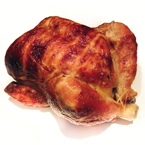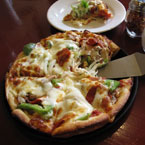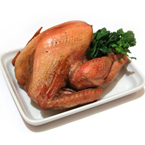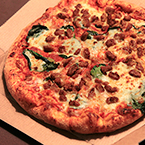Turkey
(and Thanksgiving)
The centerpiece of contemporary Thanksgiving
in the United States and Canada is a large meal,
generally centered around a large roasted turkey.
The majority of the dishes in the traditional American
version of Thanksgiving dinner are made from foods
native to the New World, as according to tradition
the Pilgrims received these foods from the Native
Americans. However, many of the classic traditions
attributed to the first Thanksgiving are actually
myths introduced later.
According to what traditionally is known as "The
First Thanksgiving," the 1621 feast between
the Pilgrims and the Wampanoag at Plymouth Colony
contained turkey, waterfowl, venison, fish, lobster,
clams, berries, fruit, pumpkin, and squash. William
Bradford noted that, "besides waterfowl, there
was great store of wild turkeys, of which they took
many." Many of the foods that were included
in that feast (except, notably, the seafood) have
since gone on to become staples of the modern Thanksgiving
dinner.
The use of the turkey in the USA for Thanksgiving
precedes Lincoln's nationalization of the holiday
in 1863. Alexander Hamilton proclaimed that no "Citizen
of the United States should refrain from turkey
on Thanksgiving Day," and many of the Founding
Fathers (particularly Benjamin Franklin) had high
regard for the wild turkey as an American icon,
but turkey was uncommon as Thanksgiving fare until
after 1800. By 1857, turkey had become part of the
traditional dinner in New England.
A Thanksgiving Day dinner served to the Civilian
Conservation Corps in 1935 included pickles, green
olives, celery, roast turkey, oyster stew, cranberry
sauce, giblet gravy, dressing, creamed asparagus
tips, snowflake potatoes, baked carrots, hot rolls,
fruit salad, mince meat pie, fruit cake, candies,
grapes, apples, French drip coffee, cigars and cigarettes.
The most common main dish of a Thanksgiving dinner,
Thanksgiving is sometimes colloquially called “Turkey
Day.” In 2006, American turkey growers were
expected to raise 270 million turkeys, to be processed
into five billion pounds of turkey meat valued at
almost $8 billion, with one third of all turkey
consumption occurring in the Thanksgiving-Christmas
season, and a per capita consumption of almost 18
pounds.
Most Thanksgiving turkeys are stuffed with a bread-based
stuffing and roasted. Sage is the traditional herb
added to the stuffing (also called dressing), along
with chopped celery, carrots, and onions. Deep-fried
turkey is rising in popularity, requiring special
fryers to hold the large bird, and reportedly leading
to fires and bad burns for those who fail to take
care when dealing with a large quantity of very
hot oil. In more recent years it is also true that
as the wild population of turkeys has rebounded
in most of the US, some will hunt and dress their
turkey in the woods and then freeze it until meal
preparation.
Butterball, a national turkey producer, runs a well-known
hotline (the "Turkey Talk Line") for those
who need assistance cooking a turkey.
(Source: Wikipedia.org)
|




















